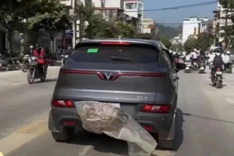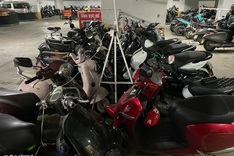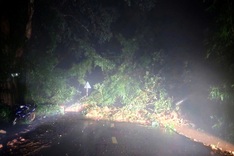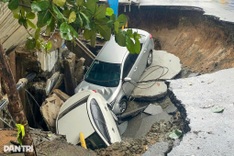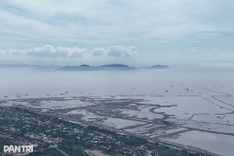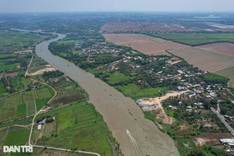The border region between China and Vietnam is bustling with trade and people come from across the region to make a living.
Luo Xianfeng, a college graduate majoring in chemicals and a native of east China's Jiangxi province, came to the Dongxing-Mong Cai border region between China and Vietnam to run its own garment business at the end of 2008. He moved to the smaller Chinese city of Dongxing from China's well-known boom town Shenzhen in Guangdong province, attracted by the huge business potential here.
When asked about his wholesale business in Mong Cai city, the largest border trade zone in northern Vietnam, the young boy who graduated from college in 2006 said modestly that his business is okay, adding that he needs more experience to make his cross-border business more profitable.
Luo is one of a group of people who came from other regions in China including Guangdong, Zhejiang and Sichuan provinces to run business in the Dongxing-Mong Cai border region. Luo is a newcomer in the cross-border region, but a middle-aged woman named Ni Yuye from east China's Zhejiang province famous for private businesses in China has been here for several years, also running a garment business.
Ni has made more money as China and its Southeast Asian neighbor Vietnam stepped up efforts to boost cross-border trade and economic cooperation. With her own apartment and car in Dongxing, she has settled in the city as her home. She got married here and now has a child.
Luo and Ni, like many other people, go across the Dongxing-Mong Cai border at around 8 o'clock every morning to work at the Vietnamese city and come back to the Chinese city at 2-3 pm as many markets in Mong Cai usually close business around the same time each day.
The Sino-Vietnam border opens from 8 am to 8 pm each day.
Gu Xiaosong, deputy president of Guangxi Academy of Social Sciences and vice president of the China Association of Southeast Asian Studies, suggested the opening hours for the border should be lengthened to 12 o'clock midnight as economic and cultural exchanges become more frequent between China and Vietnam.
"More people from both sides of the border need more time to do business, engage in business talks and visit relatives living on the other side," Gu said.
In 2009, nearly 4.9 million people crossed the Dongxing border, rising from about 4.6 million in 2008, according to Liu Quanyue, mayor of Dongxing.
The volume of trade between China and Vietnam through the Dongxing-Mong Cai border reached $2.4 billion and $4.1 billion in 2007 and 2008 respectively, the highest among the China-Vietnam border gates.
In 2009, Sino-Vietnamese trade volume rose 8.2 percent to $21.05 billion, including $16.3 billion worth of Chinese exports to Vietnam, up 7.8 percent year on year, and $4.75 billion Chinese imports from Vietnam, up 9.5 percent, according to Chinese Customs.
At the peak season, thousands of people gather to cross the Dongxing border in the morning, according to border management officials.
Dongxing, the only Chinese city with both land and sea borders with ASEAN, has a total area of 540.7 square kilometers and a population of 110,000. Mong Cai, a key Vietnamese city open to the outside world with preferential government policies, has a total area of about 520 square kilometers and a population of about 100,000.
Dongxing joins Mong Cai through a bridge of over 100 meters long on the Beilun River.
Among the cross-border working population, the majority are local Dongxing people. One of the locals, Huang Sisheng, 20 years old, helps his elder sister run a shop selling daily necessities in Mong Cai. His sister has been running the shop for more than 10 years.
Some local people in Dongxing stop their businesses in Mong Cai because it's less profitable compared with several years ago as more people start businesses in the Vietnamese city, according to Huang.
But many business people from outside Dongxing are upbeat about the business potential in the cross-border region. "The business environment will greatly improve with Vietnam formally entering the China-ASEAN free trade area (FTA) in 2015 as now we still cannot enjoy the zero-tariff policy here," Luo said.
Many people like Luo buy goods including garment, shoes and toys from south China's Guangzhou city, central China's Zhuzhou city and east China's Hangzhou's city and sell them in Mong Cai.
The China-ASEAN FTA, expected to be the third-largest free trade zone in the world in terms of total trade volume, was inaugurated on the first day of 2010.
After the launch of the China-ASEAN FTA, more than 90 percent of goods will enjoy the zero-tariff policy crossing the border between China and six old ASEAN member countries including Indonesia, Malaysia, Thailand, Singapore, the Philippines and Brunei. Vietnam, together with three other new ASEAN members, will implement the same policy from 2015.
There are also many people who go to the other side of the border every day to work for companies, according to Long Xiangdong, a Dongxing border management official.
Li Wenfan, 56, a Vietnamese carpenter, works for a furniture factory in Dongxing. He goes to work at about 8:30 every morning and goes back to his home in Mong Cai at about 6 pm.
He gets paid in Chinese currency Renminbi. More and more people choose to use RMB in daily life and business transactions as the currency is on its way to appreciation with China’s economy roaring ahead, according to local people in Dongxing and Mong Cai.
Li speaks fluent Cantonese and has no difficulty talking to people in Dongxing, which used to be a part of Guangdong province in history, as many people speak Cantonese in the Chinese city.
While many Dongxing business people sell Chinese products including home appliances in Mong Cai, a lot of Vietnamese sell their products like rosewood furniture, perfume and seafood in Dongxing.
Bai Shixing, a 24-year-old Vietnamese woman, sells Vietnamese sea food in Dongxing. She comes to Dongxing as soon as the border gate opens in the morning and goes back home to Mong Cai after she sells out her products.
She said she can understand some standard Chinese or Putonghua and local dialects of Dongxing and can even speak a little bit of the Chinese languages. "Many Vietnamese products are well welcomed in Dongxing and there are a lot of business opportunities here in China," she said.
Working across Guangxi-Vietnam border
The border region between China and Vietnam is bustling with trade and people come from across the region to make a living.
Source: China Daily



